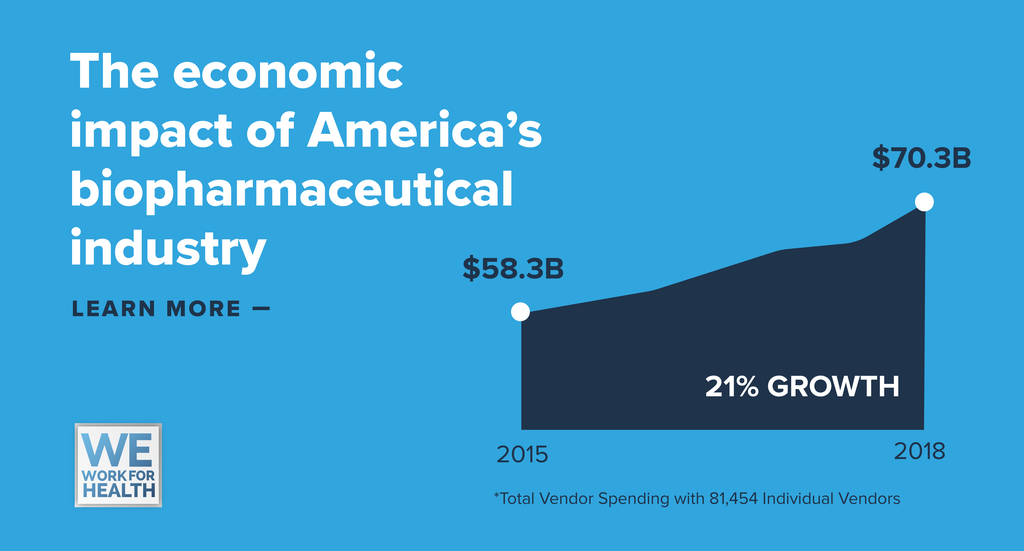Particularly in recent times, biopharmaceutical companies have become increasingly important to the American economy. But just how valuable are they? In the United States, these businesses support over 811,000 jobs and have sponsored more than 4,500 clinical trials. Impressive employment and output numbers, to be sure, but taken by themselves, these values don’t tell the whole story.
As it turns out, assessing the biopharmaceutical industry’s full impact on the U.S. is a bit more complicated. Traditional indicators alone don’t quite capture the breadth of our economic footprint. To see the whole picture, We Work For Health also measures our industry’s impact on vendors — both large and small — that provide services and supplies to our nation’s biopharmaceutical research companies.
To better gauge the industry’s economic impact, We Work For Health collected and aggregated data from 16 biopharmaceutical companies throughout the United States. These companies provided data on their business relationships with vendors, specifically, the total number of vendor relationships as well as the total expenditures paid to vendors in the United States. On this front, the data speaks for itself.
In 2018, the biopharmaceutical industry sustained business relationships with 81,454 separate vendors. That’s over 81,000 individual businesses across all fifty states (as well as Washington D.C. and Puerto Rico) that were economically impacted by the work of biopharmaceutical companies. That same year, total vendor spending topped $70.3 billion! This means that, on average, the industry paid each vendor a staggering $863,500 — quite the impact, to be sure.
"The industry is working diligently in these unprecedented times to help save lives, and the relationship between vendors and industry is more important than ever,” states Kevin Schaefer, the president of Schaefer Technologies in Indiana. “Vendors are assisting the industry in getting their much-needed products to market and the industry is assuring vendors that they are throwing their full support behind them as vendors face daunting challenges brought on by this pandemic."
Through its vendor relationships, biopharmaceutical companies generated economic activity across an impressively wide range of industries. From clinical trials and regulatory support services to computing and informatics technologies, finance, insurance, and real estate to sales, advertising and marketing, it’s difficult to identify a sector of the economy that wasn’t affected by the work of the biopharmaceutical industry.
“LightSpeedEdu, Inc. has provided education and communication services to the biopharmaceutical industry for 18 years. The industry plays an important role in generating support for companies such as ours,” explains Carlton O’Neal, the Managing Partner & Chief Operating Officer of the Connecticut-based company. “We have worked with biopharmaceutical companies in various areas including e-learning, multimedia, and virtual programs, which are beneficial especially now when so many businesses are working remotely. We look forward to continuing to find new ways to collaborate and further develop opportunities to work together.”
Clearly, the economic impact of the biopharmaceutical business is substantial. But more than that, it’s growing. Compared to the industry’s 2018 total vendor spending of $70.3 billion, 2015’s was just $58.3 billion. Over that relatively short period, industry expenditures grew by $12 billion—a nearly 21 percent increase.

States like New York, Illinois, and Pennsylvania are testaments to the industry’s burgeoning economic value. Since 2013, these states have remained the top three epicenters for biopharmaceutical spending—they know firsthand the economic benefits these companies provide.
That is a sentiment that Alan Lavine, the vice president of Percy’s TV & Appliance in Massachusetts, echoes: "Percy's is blessed and very fortunate to have great partnerships with many in the life sciences and biopharmaceutical field. It is vital for Percy's to be part of these relationships on so many levels. … We are truly appreciative and thankful for the positive impact of our partnerships with life sciences and biopharmaceutical companies."
Through the industry, businesses are supported, workers are paid, and economies are strengthened. These are the metrics that all-too-often are lost by only examining traditional indicators—but as you can see, they are vitally important. To truly understand the full economic impact of the biopharmaceutical industry, we must continue to look beyond the mere employment and output numbers and view the industry’s effect on vendors and suppliers. Otherwise, $70.3 billion can get lost in the shuffle.




